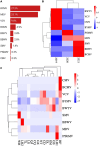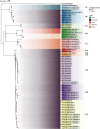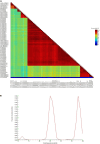Occurrence, distribution, and genetic diversity of faba bean viruses in China
- PMID: 38962134
- PMCID: PMC11219563
- DOI: 10.3389/fmicb.2024.1424699
Occurrence, distribution, and genetic diversity of faba bean viruses in China
Abstract
With worldwide cultivation, the faba bean (Vicia faba L.) stands as one of the most vital cool-season legume crops, serving as a major component of food security. China leads global faba bean production in terms of both total planting area and yield, with major production hubs in Yunnan, Sichuan, Jiangsu, and Gansu provinces. The faba bean viruses have caused serious yield losses in these production areas, but previous researches have not comprehensively investigated this issue. In this study, we collected 287 faba bean samples over three consecutive years from eight provinces/municipalities of China. We employed small RNA sequencing, RT-PCR, DNA sequencing, and phylogenetic analysis to detect the presence of viruses and examine their incidence, distribution, and genetic diversity. We identified a total of nine distinct viruses: bean yellow mosaic virus (BYMV, Potyvirus), milk vetch dwarf virus (MDV, Nanovirus), vicia cryptic virus (VCV, Alphapartitivirus), bean common mosaic virus (BCMV, Potyvirus), beet western yellows virus (BWYV, Polerovirus), broad bean wilt virus (BBWV, Fabavirus), soybean mosaic virus (SMV, Potyvirus), pea seed-borne mosaic virus (PSbMV, Potyvirus), and cucumber mosaic virus (CMV, Cucumovirus). BYMV was the predominant virus found during our sampling, followed by MDV and VCV. This study marks the first reported detection of BCMV in Chinese faba bean fields. Except for several isolates from Gansu and Yunnan provinces, our sequence analysis revealed that the majority of BYMV isolates contain highly conserved nucleotide sequences of coat protein (CP). Amino acid sequence alignment indicates that there is a conserved NAG motif at the N-terminal region of BYMV CP, which is considered important for aphid transmission. Our findings not only highlight the presence and diversity of pathogenic viruses in Chinese faba bean production, but also provide target pathogens for future antiviral resource screening and a basis for antiviral breeding.
Keywords: China; distribution; faba bean; genetic diversity; incidence; small RNA sequencing; viruses.
Copyright © 2024 Li, Qin, Zhu, Zhou, Zhao, Zhou, Wang, Chen and Cui.
Conflict of interest statement
The authors declare that the research was conducted in the absence of any commercial or financial relationships that could be construed as a potential conflict of interest.
Figures








Similar articles
-
Australian Cool-Season Pulse Seed-Borne Virus Research: 2. Bean Yellow Mosaic Virus.Viruses. 2025 May 3;17(5):668. doi: 10.3390/v17050668. Viruses. 2025. PMID: 40431680 Free PMC article. Review.
-
Integrating High throughput Sequencing into Survey Design Reveals Turnip Yellows Virus and Soybean Dwarf Virus in Pea (Pisum Sativum) in the United Kingdom.Viruses. 2021 Dec 16;13(12):2530. doi: 10.3390/v13122530. Viruses. 2021. PMID: 34960799 Free PMC article.
-
Development of rapid and simple detection of bean common mosaic virus (BCMV) in mung beans (Vigna radiata) using reverse transcription-loop mediated isothermal amplification (RT-LAMP).Virusdisease. 2025 Mar;36(1):60-67. doi: 10.1007/s13337-025-00916-y. Epub 2025 Mar 28. Virusdisease. 2025. PMID: 40290764
-
Common but Nonpersistent Acquisitions of Plant Viruses by Plant-Associated Fungi.Viruses. 2022 Oct 17;14(10):2279. doi: 10.3390/v14102279. Viruses. 2022. PMID: 36298833 Free PMC article.
-
Systemic pharmacological treatments for chronic plaque psoriasis: a network meta-analysis.Cochrane Database Syst Rev. 2021 Apr 19;4(4):CD011535. doi: 10.1002/14651858.CD011535.pub4. Cochrane Database Syst Rev. 2021. Update in: Cochrane Database Syst Rev. 2022 May 23;5:CD011535. doi: 10.1002/14651858.CD011535.pub5. PMID: 33871055 Free PMC article. Updated.
Cited by
-
Molecular Characterization and Genetic Diversity of Broad Bean Wilt Virus 2 (BBWV-2) from.ACS Omega. 2025 Jul 17;10(29):32433-32443. doi: 10.1021/acsomega.5c04600. eCollection 2025 Jul 29. ACS Omega. 2025. PMID: 40757346 Free PMC article.
-
Identification of a Broad Bean Wilt Virus 2 (BBWV2) Isolate (BBWV2-SP) from Spinacia oleracea L.Int J Mol Sci. 2025 Jun 20;26(13):5946. doi: 10.3390/ijms26135946. Int J Mol Sci. 2025. PMID: 40649722 Free PMC article.
References
-
- Bao S. Y., Wang X. M., Zhu Z. D., Zong X. X., Kumari S., Freeman A., et al. (2007). Survey of faba bean and field pea viruses in Yunnan Province, China. Australas. Plant Path. 36 347–353. 10.1071/AP07034 - DOI
LinkOut - more resources
Full Text Sources
Miscellaneous

